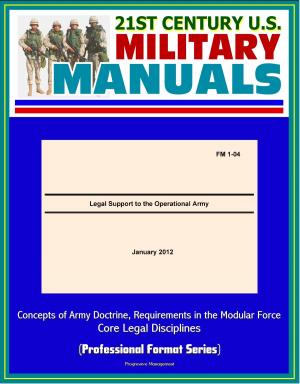The Naval Blockade: A Study of Factors Necessary for Effective Utilization - History from Before 1600, Age of Sail, Civil War Union Blockade of Confederacy, Age of Iron and Steel, Cuban Missile Crisis
Nonfiction, History, Military, Strategy, Naval| Author: | Progressive Management | ISBN: | 9781311292544 |
| Publisher: | Progressive Management | Publication: | March 8, 2016 |
| Imprint: | Smashwords Edition | Language: | English |
| Author: | Progressive Management |
| ISBN: | 9781311292544 |
| Publisher: | Progressive Management |
| Publication: | March 8, 2016 |
| Imprint: | Smashwords Edition |
| Language: | English |
Professionally converted for accurate flowing-text e-book format reproduction, this study uses historical analysis to derive factors which merit consideration by political and military planners contemplating the employment of a naval blockade as a possible option. The 1986 Joint Staff Officer's Guide, AFCS Pub 1, identifies seven military mission options available to national leaders as passable solutions to deal with international problems. Of these seven options, two specifically involve the use of a naval blockade or quarantine. The study identifies characteristics which have contributed to the success of past naval blockades and focuses on characteristics that have been common to most successful applications of the naval blockade.
The study analyzes 41 blockades or periods of blockade occurring between 425 B.C. and 1973. The study reviews these blockades in three distinct time periods; prior to 1600, during the age of sail from 1600 to 1860, and during the age of iron and steel from 1966 to 1973. Additionally, two other blockades are reviewed in detail. These include the blockade of the South during the American Civil War and the blockade of Cuba during the Cuban Missile Crisis.
The study identifies 22 characteristics which were common to most blockades. The study also reveals 23 secondary characteristics which were also found to contribute to the success of blockades. Two factors were found to be utilized in virtually all successful blockades. The first of these two characteristics was the use of superior sea power by the blockading forces. The second of these characteristics was the use of operations ashore in conjunction with the blockade. These operations took the form of an invasion by ground forces, air strike, land campaign or the imminent threat that one of these operations might be used successfully. The study also includes a review of potential future trends in operations.
CHAPTER 1 * INTRODUCTION * PURPOSE * RESEARCH QUESTION * BACKGROUND * ASSUMPTIONS * DEFINITION OF TERMS * SCOPE AND LIMITATIONS * SIGNIFICANCE OF THE STUDY * METHODOLOGY * ORGANIZATION * REVIEW OF LITERATURE * CHAPTER 2 * NAVAL BLOCKADES PRIOR TO 1600 * INTRODUCTION * THE COMBINATION OF A NAVAL BLOCKADE AND INVASION FORCES * CONTROL OF BLOCKADE RUNNERS * SUPERIOR SEA POWER AND THE USF OF A COMBINED FORCE * THE USE OF ARTIFICIAL OBSTACLES * THE EFFECT OF WEAPONS TECHNOLOGY * THE EFFECT OF BLOCKADES OVER LONG PERIODS OF TIME * USE OF A DEFENSIVE BLOCKADE * CHARACTERISTICS * CONCLUSIONS * CHAPTER 3 * NAVAL BLOCKADES IN THE AGE OF SAIL 1600-1860 * INTRODUCTION * IMPORTANCE OF THE DEFENSIVE BLOCKADE * IMPORTANCE OF ACCURATE AND TIMELY INTELLIGENCE * PROPER DISPOSITION OF BLOCKADING FORCES * NATIONS WITH EXTERNAL INTERESTS AND VITALLY DEPENDENT ON TRADE . * SUPERIOR SEA POWER * WEATHER * ABILITY TO CONDUCT RESUPPLY OF BLOCKADING FORCE * POSSESSION OF STRATEGIC BASES * ANCHORAGES ON THE FLANKS OF ENEMY TRANSIT ROUTES * USE OF NEW TECHNOLOGY * THE COMBINATION OF NAVAL BLOCKADE AND LAND OPERATIONS * IMPORTANCE OF CAPTURING KEY PORTS * THE USE OF DECEPTION * INADEQUATE LAND TRANSPORTATION INSIDE THE BLOCKADED NATION * USE OF SHALLOW DRAFT VESSELS TO BREAK BLOCKADES * THE EFFECTS OF TRAINING AND EXPERIENCE * THE INFLUENCE OF LAW ON THE BLOCKADE * SPEED CAPABILITY OF BLOCKADING SHIPS * CHARACTERISTICS * CONCLUSIONS * CHAPTER 4 * THE AMERICAN CIVIL WAR: THE UNION BLOCKADE OF THE CONFEDERACY 1861 TO 1865 * INTRODUCTION * LIMITED NUMBER OF MAJOR SOUTHERN SEAPORTS * CAPTURE OF KEY PORTS * IMPORTANCE OF STRATEGIC BASES * IMPORTANCE OF ADEQUATE LOGISTICS AND RESUPPLY * ADEQUACY OF INTERNAL TRANSPORTATION SYSTEM * GEOGRAPHIC CONSIDERATIONS * USE OF SUPERIOR SEA POWER * CONTROL OF BLOCKADE RUNNERS * more
Professionally converted for accurate flowing-text e-book format reproduction, this study uses historical analysis to derive factors which merit consideration by political and military planners contemplating the employment of a naval blockade as a possible option. The 1986 Joint Staff Officer's Guide, AFCS Pub 1, identifies seven military mission options available to national leaders as passable solutions to deal with international problems. Of these seven options, two specifically involve the use of a naval blockade or quarantine. The study identifies characteristics which have contributed to the success of past naval blockades and focuses on characteristics that have been common to most successful applications of the naval blockade.
The study analyzes 41 blockades or periods of blockade occurring between 425 B.C. and 1973. The study reviews these blockades in three distinct time periods; prior to 1600, during the age of sail from 1600 to 1860, and during the age of iron and steel from 1966 to 1973. Additionally, two other blockades are reviewed in detail. These include the blockade of the South during the American Civil War and the blockade of Cuba during the Cuban Missile Crisis.
The study identifies 22 characteristics which were common to most blockades. The study also reveals 23 secondary characteristics which were also found to contribute to the success of blockades. Two factors were found to be utilized in virtually all successful blockades. The first of these two characteristics was the use of superior sea power by the blockading forces. The second of these characteristics was the use of operations ashore in conjunction with the blockade. These operations took the form of an invasion by ground forces, air strike, land campaign or the imminent threat that one of these operations might be used successfully. The study also includes a review of potential future trends in operations.
CHAPTER 1 * INTRODUCTION * PURPOSE * RESEARCH QUESTION * BACKGROUND * ASSUMPTIONS * DEFINITION OF TERMS * SCOPE AND LIMITATIONS * SIGNIFICANCE OF THE STUDY * METHODOLOGY * ORGANIZATION * REVIEW OF LITERATURE * CHAPTER 2 * NAVAL BLOCKADES PRIOR TO 1600 * INTRODUCTION * THE COMBINATION OF A NAVAL BLOCKADE AND INVASION FORCES * CONTROL OF BLOCKADE RUNNERS * SUPERIOR SEA POWER AND THE USF OF A COMBINED FORCE * THE USE OF ARTIFICIAL OBSTACLES * THE EFFECT OF WEAPONS TECHNOLOGY * THE EFFECT OF BLOCKADES OVER LONG PERIODS OF TIME * USE OF A DEFENSIVE BLOCKADE * CHARACTERISTICS * CONCLUSIONS * CHAPTER 3 * NAVAL BLOCKADES IN THE AGE OF SAIL 1600-1860 * INTRODUCTION * IMPORTANCE OF THE DEFENSIVE BLOCKADE * IMPORTANCE OF ACCURATE AND TIMELY INTELLIGENCE * PROPER DISPOSITION OF BLOCKADING FORCES * NATIONS WITH EXTERNAL INTERESTS AND VITALLY DEPENDENT ON TRADE . * SUPERIOR SEA POWER * WEATHER * ABILITY TO CONDUCT RESUPPLY OF BLOCKADING FORCE * POSSESSION OF STRATEGIC BASES * ANCHORAGES ON THE FLANKS OF ENEMY TRANSIT ROUTES * USE OF NEW TECHNOLOGY * THE COMBINATION OF NAVAL BLOCKADE AND LAND OPERATIONS * IMPORTANCE OF CAPTURING KEY PORTS * THE USE OF DECEPTION * INADEQUATE LAND TRANSPORTATION INSIDE THE BLOCKADED NATION * USE OF SHALLOW DRAFT VESSELS TO BREAK BLOCKADES * THE EFFECTS OF TRAINING AND EXPERIENCE * THE INFLUENCE OF LAW ON THE BLOCKADE * SPEED CAPABILITY OF BLOCKADING SHIPS * CHARACTERISTICS * CONCLUSIONS * CHAPTER 4 * THE AMERICAN CIVIL WAR: THE UNION BLOCKADE OF THE CONFEDERACY 1861 TO 1865 * INTRODUCTION * LIMITED NUMBER OF MAJOR SOUTHERN SEAPORTS * CAPTURE OF KEY PORTS * IMPORTANCE OF STRATEGIC BASES * IMPORTANCE OF ADEQUATE LOGISTICS AND RESUPPLY * ADEQUACY OF INTERNAL TRANSPORTATION SYSTEM * GEOGRAPHIC CONSIDERATIONS * USE OF SUPERIOR SEA POWER * CONTROL OF BLOCKADE RUNNERS * more















